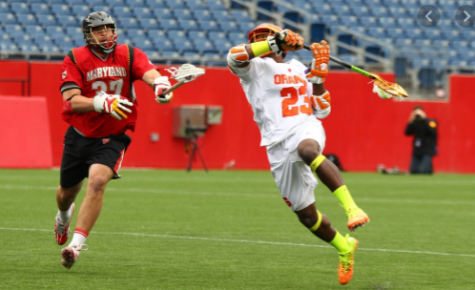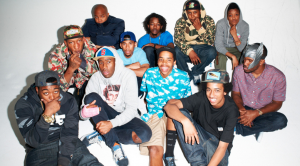The Lack of Diversity in Lacrosse
February 13, 2020
This is an opinion piece written by Lindsay Kupka. Lindsay is a staff writer, but the ideas and opinions expressed in this article may not fully represent the views of The Patriot.
Even though lacrosse is the fastest growing sport in the United States, the lack of racial diversity remains stagnant. Lacrosse was created by Native Americans in the Great Lakes Area which has been noted by European colonization and missionaries. For Native Americans, the sport carries a very sentimental and spiritual meaning. They believe that the game’s origins are “rooted in legend, and the game continues to be used for curative purposes and surrounded with the ceremony” and they also believe that “team selection and victory are often considered supernaturally controlled” (US Lacrosse).

After its discovery, lacrosse grew in popularity throughout Canada and was given its name by French settlers near Montreal. The French settlers in the mid-nineteenth century changed the rules of lacrosse in an attempt to make it more civilized, taking away a lot of the originality and uniqueness of the Native Americans. The sport quickly became popular down the Eastern seaboard, to the point where it is today.
For the past 30 years, lacrosse has been growing in popularity across the United States. According to a recent study from the Sports and Fitness Association, participation has grown 10% since 2017, and 25% since 2012. Although the vast majority of division 1 college programs are centralized around the East Coast, both the Midwest and West regions have schools that have entered the national title conversation, in both men’s and women’s lacrosse. Schools like Ohio State, Notre Dame, Michigan, Denver, Northwestern, and Stanford have all made a name for themselves on the national radar. However, although lacrosse is expanding regionally and seems to be inclusive, for many years there has been a racial stigma around the sport.
In my experience, I can count on one hand the amount of times I have played with a non-white girl. According to the most recent NCAA Study, just 3.5% of men’s D1 players and 2.9% are black. Perhaps this is due to the toxicity and white privilege that surrounds the sport of lacrosse. Kyle Harrison, a former college lacrosse player and 3 time All-American at Johns Hopkins and now a member of the Redwoods for the Professional Lacrosse League grew up playing comfortably and said that because of his father, “being the only black kid on the team, it didn’t phase [him] at all” (Harrison). Although Harrison was not treated badly by his teammates or by opposing players, many other black lacrosse players grew up as victims of systemic racism on the field. Another player, Chazz Woodson who played at Brown from 2002-2005, said that a racial epithet had been directed at him three times over his collegiate career- once from an opposing player and twice from teammates. When he was called the N-word during a game by an opponent, Woodson knew that being called a racial slur wouldn’t go viral, but a black lacrosse player getting into a fight would. Some may argue that because these occurrences happened a long time ago, that racism in lacrosse has improved exponentially and that black and other non-white players do not have to deal with the treatment that players before them did or that if the players are committing the persecution, it isn’t that big of a deal. However, in 2013, Syracuse men’s assistant coach, Lelan Rogers, was directing a film session and used the Jim Crow racial slur of “colored” to refer to an opposing player. Drew Jenkins, a black midfielder at Syracuse, asked Rogers for an apology twice and was brushed off. Only after threatening to boycott the next game and to get his father involved, did Rogers give him an apology. After the incident went public, Jenkins’ story was published in the New York Times but Jenkins did not expect the reactions of other people. People who read the article said that Jenkins was “overreacting or soft” Jenkins felt that “lacrosse had turned its back on [him]” (Jenkins).
One of the big problems surrounding diversity in lacrosse is that many people have never been educated on inclusion and equity. Jovan Miller, a former Syracuse, and MLL midfielder describes it as white players grow up playing and see very few kids who do not look like them. In a vicious cycle, these players learn bias from their coaches, and then these kids grow up to become coaches with the same perspectives and the mindset is implanted into many people. On February 1st, 2018, Jovan Miller posted a letter on his blog entitled “Dear Lacrosse”. In this letter, he outlines his disappointment with the sport and how the sport handles diversity. Miller, a prominent figure and advocate for diversity in lacrosse, is disappointed with how the lacrosse community addresses the problem of racism. Too many times, the instance is pushed under the rug and brushed off. Jovan Miller says that at least 20+ times, the issue was blatantly ignored. To be more inclusive in this sport, Miller says that players and coaches must understand “appropriate and inappropriate etiquette on and off the field” (Miller).

If the sport of lacrosse is going to continue growing as rapidly in the future, then the sport must find a way to be more racially inclusive. I myself, have used the vague hashtag which does not specifically address the problems minorities face and just outlines the geographical growth, “#growthegame”, and have been ignorant in the past to the hardships that racial minorities face when playing lacrosse. Many players get angry when others make fun of it for stereotypically being a sport where only wealthy, white people play. It is our generation’s responsibility and obligation to change the stereotype and be more inclusive by destroying our toxicity and valuing others’ skills, with disregard for our race. By only wanting lacrosse to grow geographically and not racially, racist players only hurt the potential for the growth of lacrosse as a whole. Lacrosse players should no longer embrace the exclusionary affluence of lacrosse and should celebrate when others have skills, even if they are different than each other. The possibility of lacrosse being a sport on the national level with even higher participation numbers is real, but it will only be truly accomplished when the threat of not being bullied by others for their race is dismantled.









